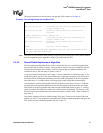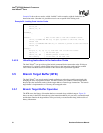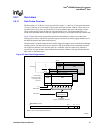
92 Hardware Reference Manual
Intel
®
IXP2800 Network Processor
Intel XScale
®
Core
3.4.2 Instruction Cache Control
3.4.2.1 Instruction Cache State at Reset
After reset, the instruction cache is always disabled, unlocked, and invalidated (flushed).
3.4.2.2 Enabling/Disabling
The instruction cache is enabled by setting bit 12 in coprocessor 15, register 1 (Control register).
This process is illustrated in Example 18.
3.4.2.3 Invalidating the Instruction Cache
The entire instruction cache along with the fetch buffers are invalidated by writing to
coprocessor 15, register 7. This command does not unlock any lines that were locked in the
instruction cache nor does it invalidate those locked lines. To invalidate the entire cache including
locked lines, the unlock instruction cache command needs to be executed before the invalidate
command.
There is an inherent delay from the execution of the instruction cache invalidate command to
where the next instruction will see the result of the invalidate. The routine in Example 19 can be
used to guarantee proper synchronization.
The Intel XScale
®
core also supports invalidating an individual line from the instruction cache.
3.4.2.4 Locking Instructions in the Instruction Cache
Software has the ability to lock performance critical routines into the instruction cache. Up to
28 lines in each set can be locked; hardware will ignore the lock command if software is trying to
lock all the lines in a particular set (i.e., ways 28 – 31can never be locked). When this happens, the
line is still allocated into the cache, but the lock will be ignored. The round-robin pointer will stay
at way 31 for that set.
Lines can be locked into the instruction cache by initiating a write to coprocessor 15. Register Rd
contains the virtual address of the line to be locked into the cache.
Example 18. Enabling the Instruction Cache
; Enable the ICache
MRC P15, 0, R0, C1, C0, 0 ; Get the control register
ORR R0, R0, #0x1000 ; set bit 12 -- the I bit
MCR P15, 0, R0, C1, C0, 0 ; Set the control register
CPWAIT
Example 19. Invalidating the Instruction Cache
MCR P15,0,R1,C7,C5,0 ; Invalidate the instruction cache and branch
; target buffer
CPWAIT
; The instruction cache is guaranteed to be invalidated at this point; the next
; instruction sees the result of the invalidate command.


















